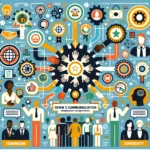The IELTS Reading section tests your ability to understand complex texts and answer questions accurately. One topic that has gained significant attention in recent years is the impact of remote work on urban economies. This subject has become increasingly relevant due to the global shift towards flexible working arrangements, especially in the wake of the COVID-19 pandemic. Based on current trends, it’s highly likely that this theme will continue to appear in future IELTS exams.
To help you prepare for this potential topic, we’ve created a practice reading passage with accompanying questions. This exercise will not only familiarize you with the content but also hone your skills in tackling various question types commonly found in the IELTS Reading test.
Reading Passage
The Reshaping of Urban Landscapes: Remote Work’s Economic Ripple Effect
The rise of remote work has triggered a seismic shift in urban economies, reshaping the very fabric of city life. As more companies embrace flexible working arrangements, the traditional notion of centralized business districts is being challenged, leading to far-reaching consequences for urban areas worldwide.
One of the most immediate impacts of remote work on urban economies is the transformation of commercial real estate. With fewer employees commuting to centralized offices, demand for prime office space in city centers has plummeted. This shift has led to increased vacancy rates and declining property values in once-thriving business districts. Some cities are now grappling with the challenge of repurposing these vacant spaces, exploring options such as converting offices into residential units or mixed-use developments.
The ripple effect of this change extends far beyond the real estate sector. Local businesses that relied heavily on the daily influx of office workers – such as cafes, restaurants, and retail shops – have seen a significant drop in foot traffic and revenue. This downturn has forced many establishments to close their doors permanently, altering the economic landscape of urban centers and potentially leading to job losses in the service sector.
However, the impact of remote work on urban economies is not entirely negative. As workers gain more flexibility in choosing where to live, there has been a notable migration away from expensive city centers to suburban and rural areas. This shift has led to the revitalization of smaller towns and cities, which are now experiencing an influx of skilled workers and increased economic activity. These areas are benefiting from the spending power of remote workers who bring their city salaries to regions with lower costs of living.
Moreover, the decentralization of work has sparked innovation in urban planning and infrastructure development. Cities are now focusing on creating more livable spaces that cater to residents’ needs beyond just facilitating commutes to work. This includes investments in green spaces, improved public transportation, and the development of “15-minute cities” where essential services are within walking or biking distance of residential areas.
The tech sector has also seen a boom in response to the remote work trend. Companies providing virtual collaboration tools, cybersecurity solutions, and home office equipment have experienced unprecedented growth. This has created new job opportunities and contributed to the emergence of tech hubs in areas previously overlooked by the industry.
Despite these positive developments, the shift to remote work has exposed and sometimes exacerbated existing inequalities in urban areas. Workers in sectors that cannot be performed remotely, such as manufacturing, healthcare, and essential services, have not benefited from the flexibility and potential cost savings associated with working from home. This disparity has led to concerns about a widening economic gap within urban populations.
Looking ahead, the long-term impact of remote work on urban economies remains uncertain. While some experts predict a permanent shift in work patterns and urban development, others anticipate a gradual return to pre-pandemic norms. What is clear, however, is that cities will need to adapt to these changing dynamics to remain economically viable and attractive to both businesses and residents.
As urban planners and policymakers grapple with these challenges, they are exploring innovative solutions to create more resilient and adaptable urban economies. This may involve diversifying city centers to reduce reliance on a single industry, investing in digital infrastructure to support remote work, and developing new models of taxation to account for the changing nature of work and residence.
The impact of remote work on urban economies is a complex and evolving phenomenon. While it presents significant challenges, it also offers opportunities for reimagining urban spaces and creating more sustainable, inclusive cities for the future. As this trend continues to unfold, its effects will likely shape the economic landscape of cities for generations to come.
 Urban remote work impact
Urban remote work impact
Questions
True/False/Not Given
For questions 1-5, decide if the statements are True, False, or Not Given based on the information in the passage.
- Remote work has led to an increase in demand for office space in city centers.
- Some cities are considering converting empty office spaces into residential units.
- Rural areas have experienced economic growth due to the influx of remote workers.
- All sectors of the urban economy have benefited equally from the shift to remote work.
- The long-term effects of remote work on urban economies are definitively known.
Multiple Choice
Choose the correct letter, A, B, C, or D.
-
According to the passage, which of the following has been a direct result of the increase in remote work?
A) An increase in property values in city centers
B) A rise in foot traffic for urban businesses
C) A decline in demand for prime office space
D) An expansion of manufacturing jobs in cities -
The concept of “15-minute cities” mentioned in the passage refers to:
A) Cities where the average commute time is 15 minutes
B) Urban areas where essential services are within a short distance of homes
C) Business districts that operate on 15-minute work intervals
D) Cities with a 15% increase in remote workers
Matching Headings
Match the following headings to the correct paragraphs in the passage. Write the correct number i-viii next to questions 8-11.
i. The rise of suburban economies
ii. Challenges for urban planners
iii. The impact on commercial real estate
iv. Technological advancements in remote work
v. The future of urban development
vi. Effects on local businesses
vii. Widening economic disparities
viii. Innovations in urban planning
- Paragraph 2: _____
- Paragraph 3: _____
- Paragraph 5: _____
- Paragraph 7: _____
Summary Completion
Complete the summary below using words from the box. Write the correct letter A-J next to questions 12-15.
A) revitalization B) centralized C) flexible D) permanent E) inequalities
F) uncertain G) resilient H) viable I) adaptive J) innovative
The shift to remote work has had a significant impact on urban economies, challenging the traditional model of (12) business districts. While this has led to challenges for some sectors, it has also resulted in the (13) of smaller towns and rural areas. The long-term effects remain (14) , prompting cities to explore (15) solutions to remain economically viable.
Answer Key and Explanations
-
False – The passage states that “demand for prime office space in city centers has plummeted.”
-
True – The text mentions “exploring options such as converting offices into residential units.”
-
True – The passage notes that smaller towns and cities are “experiencing an influx of skilled workers and increased economic activity.”
-
False – The text highlights that workers in sectors that cannot be performed remotely have not benefited equally.
-
Not Given – The passage states that “the long-term impact of remote work on urban economies remains uncertain.”
-
C – The passage directly states that “demand for prime office space in city centers has plummeted.”
-
B – The text defines “15-minute cities” as places “where essential services are within walking or biking distance of residential areas.”
-
iii – This paragraph discusses the impact on commercial real estate.
-
vi – This paragraph focuses on the effects on local businesses like cafes and restaurants.
-
viii – This paragraph discusses new approaches to urban planning in response to remote work.
-
vii – This paragraph addresses the widening economic gap due to remote work opportunities.
-
B – The passage refers to “centralized business districts” being challenged.
-
A – The text mentions the “revitalization of smaller towns and cities.”
-
F – The passage states that “the long-term impact of remote work on urban economies remains uncertain.”
-
J – The text discusses “innovative solutions” being explored by urban planners and policymakers.
Common Mistakes to Avoid
- Overlooking key qualifiers: Pay attention to words like “some,” “many,” or “potentially” that may affect the accuracy of a statement.
- Making assumptions: Stick to the information provided in the text and avoid drawing conclusions based on personal knowledge or opinions.
- Misinterpreting “Not Given”: Remember that “Not Given” means the information is neither confirmed nor denied in the passage.
- Rushing through the text: Take time to understand the overall structure and main ideas of the passage before answering questions.
Vocabulary Focus
- Seismic shift: A major change or transformation
- Plummeted: Fallen or dropped rapidly
- Ripple effect: The spreading results of an event or action
- Revitalization: The process of making something grow, develop, or become successful again
- Exacerbated: Made worse or more severe
- Resilient: Able to withstand or recover quickly from difficult conditions
Grammar Spotlight
Pay attention to the use of present perfect tense in sentences like “The rise of remote work has triggered a seismic shift in urban economies.” This tense is used to describe actions that started in the past and continue to have relevance or impact in the present.
Tips for IELTS Reading Success
- Practice active reading: Engage with the text by highlighting key points and making mental summaries as you read.
- Improve your time management: Allocate your time wisely between reading the passage and answering questions.
- Expand your vocabulary: Regularly learn new words and phrases related to urban development, economics, and technology.
- Familiarize yourself with different question types: Practice with various IELTS question formats to improve your speed and accuracy.
- Read widely: Expose yourself to diverse texts on current affairs, including articles on urbanization and social inequality and the effects of urbanization on local economies.
By focusing on these strategies and regularly practicing with passages like this one on the rise of remote work and its influence on global workforce trends, you’ll be well-prepared to tackle the IELTS Reading section with confidence. Remember, consistent practice and a methodical approach are key to achieving a high score in the IELTS exam.


